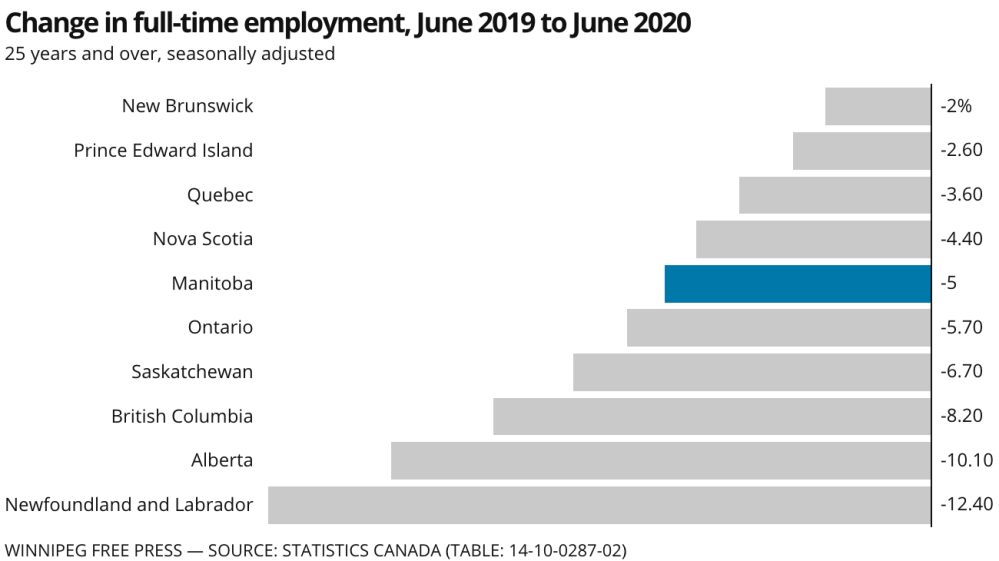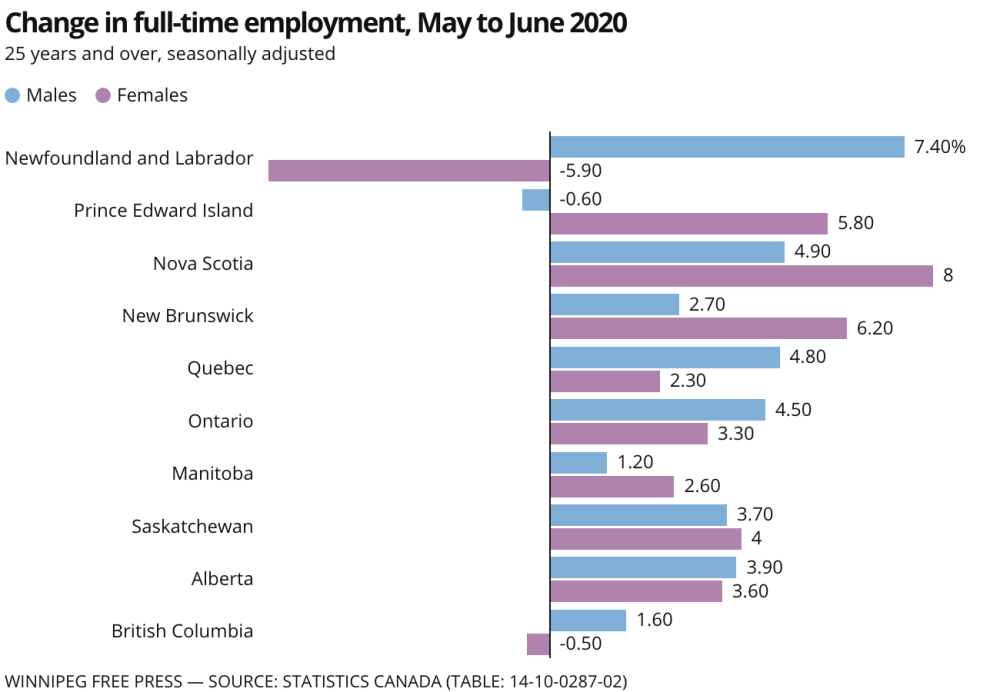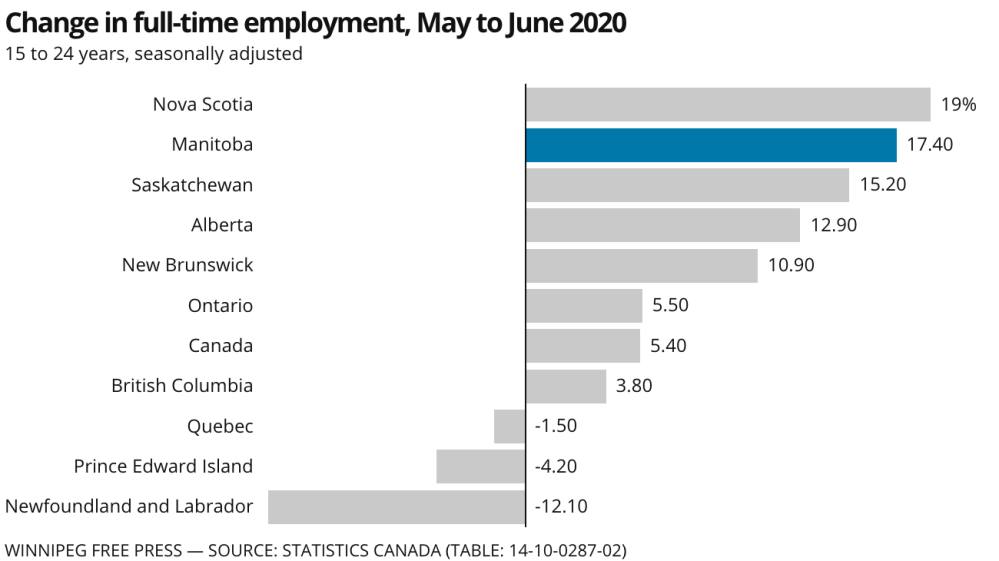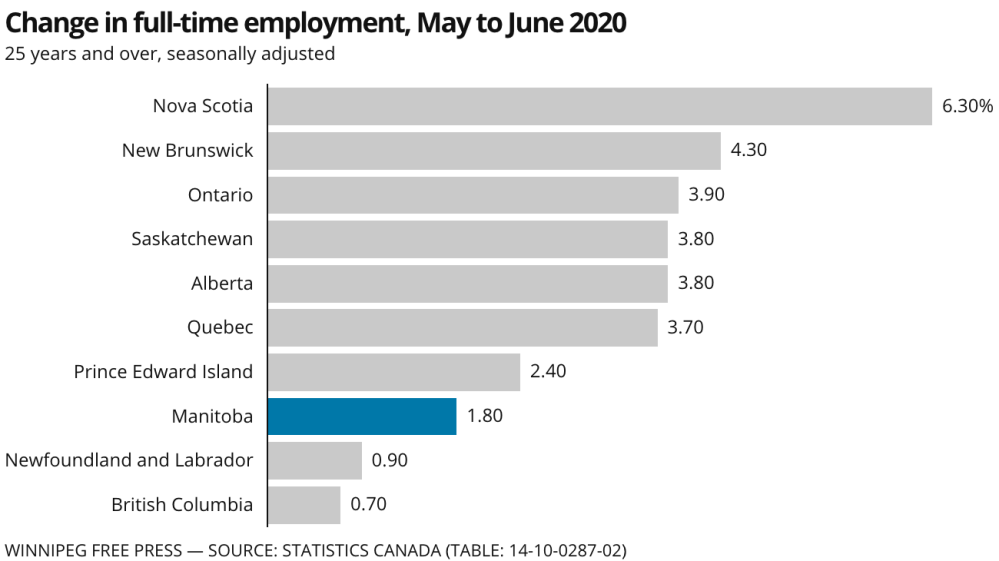Job stats show Manitoba economy bouncing back
Read this article for free:
or
Already have an account? Log in here »
To continue reading, please subscribe:
Monthly Digital Subscription
$0 for the first 4 weeks*
- Enjoy unlimited reading on winnipegfreepress.com
- Read the E-Edition, our digital replica newspaper
- Access News Break, our award-winning app
- Play interactive puzzles
*No charge for 4 weeks then price increases to the regular rate of $19.00 plus GST every four weeks. Offer available to new and qualified returning subscribers only. Cancel any time.
Monthly Digital Subscription
$4.75/week*
- Enjoy unlimited reading on winnipegfreepress.com
- Read the E-Edition, our digital replica newspaper
- Access News Break, our award-winning app
- Play interactive puzzles
*Billed as $19 plus GST every four weeks. Cancel any time.
To continue reading, please subscribe:
Add Free Press access to your Brandon Sun subscription for only an additional
$1 for the first 4 weeks*
*Your next subscription payment will increase by $1.00 and you will be charged $16.99 plus GST for four weeks. After four weeks, your payment will increase to $23.99 plus GST every four weeks.
Read unlimited articles for free today:
or
Already have an account? Log in here »
Hey there, time traveller!
This article was published 10/07/2020 (1978 days ago), so information in it may no longer be current.
Manitoba’s labour force recovery is the second strongest among the provinces, but who deserves the credit for it is in dispute.
In June, the employment level in Manitoba was 92.8 per cent of where it was in pre-pandemic February, Statistics Canada’s June Labour Force Survey said.
New Brunswick, the first province to begin easing COVID-19 restrictions, had the highest employment level, at 97.1 per cent of the pre-COVID level in February. Ontario’s employment level was the lowest among the provinces, at 89.7 per cent of where it was in February.
The big picture
About 5.5 million Canadian workers were affected by the COVID-19 economic shutdown from February to April. This included a drop in employment of 3.0 million and a COVID-related increase in absences from work of 2.5 million.
About 5.5 million Canadian workers were affected by the COVID-19 economic shutdown from February to April. This included a drop in employment of 3.0 million and a COVID-related increase in absences from work of 2.5 million.
By the week of June 14 to 20, the number of workers affected by the COVID-19 economic shutdown was 3.1 million, a reduction of 43 per cent from April.
The economic hit from COVID-19 has been unprecedented in its speed and depth, but so has the comeback.
Employment fell to 15.7 per cent below pre-COVID February levels in just two months.
By comparison, the 1981-82 recession resulted in a total employment decline of 5.4 per cent over approximately 17 months.
With the easing of COVID-19 restrictions in May and June, the initial recovery of employment — to within 9.2 per cent of pre-COVID levels — has been sharper than in previous downturns, when recovery to pre-downturn employment has taken from two to five years.
— source: Statistics Canada
The survey looked at labour market conditions for the week of June 14 to 20. By then, public health restrictions had been substantially eased in most parts of the country. Manitoba was already well into Phase 2 of its recovery, which began June 1. It allowed larger indoor and outdoor gatherings, restaurants and bars to serve indoors at 50 per cent capacity, and more personal services to reopen.
“The June job numbers report, we think, is a very positive step in the right direction,” Manitoba Finance Minister Scott Fielding said Friday. The province lost about 90,000 jobs because of the pandemic shutdown, he said. Over the last two months, more than 42,000 Manitobans have returned to work.
“Manitoba will have the second-lowest unemployment rate and, almost more importantly, the youth unemployment rate will be the lowest in Canada,” Fielding said at a press conference.
The provincial unemployment rate edged down to 10.1 per cent, the second lowest in the country and below the national rate of 12.3 per cent. Manitoba’s youth unemployment rate decreased 3.5 percentage points to 19.3 per cent, the lowest in Canada, he said. Fielding said that’s because of provincial job creation programs, including the Summer Student Job Recovery Program in which 1,800 employers apply for $20 million in wage subsidies for more than 4,000 student positions.
He credited his government’s pandemic spending plan for helping the recovery. The Manitoba Gap Protection Program he said has provided nearly $44.6 million to more than 7,400 businesses that are ineligible for federal support. The Manitoba Back to Work This Summer Program has put up more than $3 million so 220 private-sector employers could hire and rehire 600 employees.
The NDP’s finance critic said the Tories shouldn’t try to take credit for Manitoba’s positive labour force numbers.
“If anything, the Pallister Conservatives have made things worse,” Mark Wasyliw told reporters. The June job numbers, he said, are a natural byproduct of lifting lockdown measures.
“We can only imagine the opportunities lost and how much better the numbers would’ve been if they’d actually done something,” said Wasyliw. The province laid off workers, cut wages and had to be “shamed into bringing in some economic programs,” he said. Those have been convoluted, hard to apply for, don’t cover many people and have had little uptake, he said. Only $45,000 of an $18-million fund for child care has been spent, for example, said Wasyliw.
“We’ve been calling on them for months to provide supports to small businesses and daycare centres. Until you address those fundamentals, you’re not going to see big benefits to your economy,” said Wasyliw.
Fielding said only Quebec is spending more than Manitoba to support people affected by COVID-19.
By GDP, Manitoba’s $2.1 billion in planned COVID-19 responses puts it as the second-highest spender at 2.9 per cent, behind Quebec spending 6.5 per cent ($28.7 billion) of its GDP on pandemic support, Fielding said.
“Manitoba must grow it’s way out of this crisis, not cut its way out of this crisis,” the finance minister said. To do that, the province is investing in preparedness — on things like personal protective equipment, and in jobs and growth, he said.
“Our No. 1 goal is to keep Manitobans safe. Manitoba is one of the safest places in North America now because of low COVID numbers,” he said.
So far this month, there have been no new cases of COVID-19 and as of Friday, Manitoba had only four active cases. On Thursday, 928 laboratory tests were performed, raising the provincial total since early February to 69,036 tests. So far, there have been only 325 positive results.
“We were one of the last provinces to go into shutdown and one of the first to come out of it and, more importantly than anything, we have some of the lowest (COVID-19) numbers, so people feel safe,” he said.
Fielding said he won’t be happy until all of the nearly 50,000 Manitobans who are off the job because of the pandemic are back at work. “We anticipate them coming back by year’s end.”
When asked why 246,440 Manitobans have registered for the Canada Emergency Response Benefit (CERB) if only 90,000 couldn’t work during the pandemic, the finance minister couldn’t offer a rationale.
“I’m not going to suggest Manitobans didn’t need it,” said Fielding.
Premier Brian Pallister, meanwhile, has railed against the federal support program. He argues it has stalled Manitoba’s recovery by discouraging people from getting back to work, saying it was time “to kick CERB to the curb.”
So far, more than 1,900 people have applied for the Manitoba Job Restart Program to receive a $2,000 payment if they return to work and stop collecting the CERB or the Canada Emergency Student Benefit, Fielding said. The deadline to apply for the program is July 31.
Fielding didn’t criticize the federal benefit program. “I think all governments have done a decent job getting programs out quickly,” he said. Besides, he said, the federal government has indicated the CERB is being phased out as the economy recovers and more employers get the Canada Emergency Wage Subsidy that covers 75 per cent of an employee’s wages.
carol.sanders@freepress.mb.ca

Our newsroom depends on a growing audience of readers to power our journalism. If you are not a paid reader, please consider becoming a subscriber.
Our newsroom depends on its audience of readers to power our journalism. Thank you for your support.
History
Updated on Friday, July 10, 2020 8:14 PM CDT: Fixes typos








